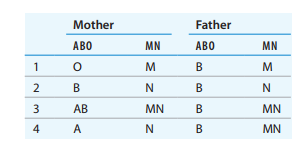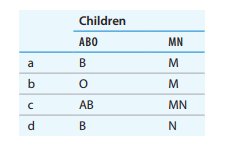
Genetic Analysis: An Integrated Approach (3rd Edition)
3rd Edition
ISBN: 9780134605173
Author: Mark F. Sanders, John L. Bowman
Publisher: PEARSON
expand_more
expand_more
format_list_bulleted
Concept explainers
Textbook Question
Chapter 4, Problem 6P
The


Expert Solution & Answer
Want to see the full answer?
Check out a sample textbook solution
Students have asked these similar questions
This entire structure (Pinus pollen cone) using lifecycle terminology is called what?
This entire structure using lifecycle terminology is called what?
megastrobilus
microstrobilus
megasporophyll
microsporophyll
microsporangium
megasporangium
none of these
How much protein should Sarah add to her diet if she gets pregnant?
Sarah's protein requirements during pregnancy would be higher. See Hint B2.
During calculations, use numbers rounded to the first decimal place. In your answer, round the number of grams to the nearest whole number.
_______ g ?
Chapter 4 Solutions
Genetic Analysis: An Integrated Approach (3rd Edition)
Ch. 4 - 1. Define and distinguish incomplete penetrance...Ch. 4 -
2. Define and distinguish epistasis and...Ch. 4 - When working on barley plants, two researchers...Ch. 4 - Fifteen bacterial colonies growing on a complete...Ch. 4 - 5. In a type of parakeet known as a “budgie,”...Ch. 4 - 6. The and blood groups are given below for four...Ch. 4 - The wild-type color of horned beetles is black,...Ch. 4 - 8. Two genes interact to produce various...Ch. 4 - Prob. 9PCh. 4 - 10. In rats, gene produces black coat color if the...
Ch. 4 - 11. In the rats identified in Problem, a third...Ch. 4 - Using the information provided in Problems 10 and...Ch. 4 - 13. Total cholesterol in blood is reported as the...Ch. 4 - 14. Flower color in snapdragons results from the...Ch. 4 - 5. A plant line with reduced fertility comes to...Ch. 4 - Prob. 16PCh. 4 - The coat color in mink is controlled by two...Ch. 4 - Prob. 18PCh. 4 - 19. Feather color in parakeets is produced by the...Ch. 4 - Brachydactyly type D is a human autosomal dominant...Ch. 4 - 21. A male and a female mouse are each from...Ch. 4 - Xerodermapigmentosum (XP) is an autosomal...Ch. 4 - 23. Three strains of green-seeded lentil plants...Ch. 4 - Blue flower color is produced in a species of...Ch. 4 - 25. The following crosses are performed between...Ch. 4 - Two pure-breeding strains of summer squash...Ch. 4 - Marfan syndrome is an autosomal dominant disorder...Ch. 4 - 28. Yeast are single-celled eukaryotic organisms...Ch. 4 - Prob. 29PCh. 4 - Dr. Ara B. Dopsis and Dr. C. Ellie Gans are...Ch. 4 - Human ABO blood type is determined by three...Ch. 4 - In rabbits, albinism is an autosomal recessive...Ch. 4 - Dr. O. Sophila, a close friend of Dr. Ara B....Ch. 4 - In a breed of domestic cattle, horns can appear on...Ch. 4 - Prob. 35PCh. 4 - Prob. 36PCh. 4 - 37. Epistatic gene interaction results in a...Ch. 4 - 38. Draw a pedigree containing two parents and...
Knowledge Booster
Learn more about
Need a deep-dive on the concept behind this application? Look no further. Learn more about this topic, biology and related others by exploring similar questions and additional content below.Similar questions
- C MasteringHealth MasteringNu X session.healthandnutrition-mastering.pearson.com/myct/itemView?assignment ProblemID=17396422&attemptNo=1&offset=prevarrow_forwardMost people, even those who exercise regularly at low to average intensity (1 hour at the gym or a 2- to 3-mile walk several times per week), do not need an increased protein intake. What would be the protein needs of a man named Josh who exercises moderately and is the same age and size as Wayne? Josh is 5 ft, 8 in tall and weighs 183 lb. Round the number of grams to the nearest whole number. During calculations, use numbers rounded to the first decimal place. Because protein requirement is a range, please enter two numbers: lower and upper range values, respectively. Separate the lower and upper range values, in that order, by a comma. ___, ___ g ?arrow_forwardC MasteringHealth MasteringNu X session.healthandnutrition-mastering.pearson.com/myct/itemView?assignment ProblemID=17396422&attemptNo=1&offset=prevarrow_forwardIf left untreated, most HIV-infected individuals will develop AIDS. Current treatments are focused on highlyactive antiretroviral therapy (HAART). HAART usually consists of an orally delivered drug cocktail containingtwo different reverse transcriptase inhibitors and one other drug, such as a protease inhibitor. Question: Develop a pharmacokinetic model of HAART treatment. Consider all 3 drugs. Make sure to include adiagram that illustrates your thinking, state all assumptions, and define your variables. Whatparameters would you need to know to find the concentration of drug in the plasma? In the T cells?(You do not need to write out or solve any equations.)arrow_forwardnot use ai pleseaarrow_forward(A) 25 20 20 15 NPP (Mg C/ha/yr) 10 10 5 0 0 2,000 4,000 6,000 ECOLOGY 4e, Figure 20.11 (Part 1) 2017 Sinauer Associates, Inc. Average annual precipitation (mm) 8,000arrow_forwardexplain the cascade of events (starting with relaxing trade winds) that occurs during El Niño in the eastern Pacific (off the coasts of California/North America and Peru/South America) and which lead to food-chain collapse - start with changes in the physical/oceanographic conditions, andthen systematically describe the cascading effects at each level of the food chain -arrow_forward3) Which statement(s) about the Pacific Decadal Oscillation (PDO) is/are TRUE? CIRCLE ALL THAT APPLY. A. It is a major driver of salmon populations in the Pacific B. It affects sea surface temperatures in the eastern Pacific C. Its cycles typically do not last as long as those of ENSO D. Evidence that it has occurred over many centuries has been gathered from tree ring dataarrow_forward4.arrow_forward2arrow_forward1. 2. 3. Marine fish cells are hypotonic compared to their seawater environment; their cells lose water by osmosis and gain solutes. If you add heterotrophic respiration and autotrophic respiration together and then subtract that value from gross primary productivity, then you have a more refined estimate of ecosystem carbon storage than NEE. Differential heating due to the earth's tilt generates the global wind AND oceanic circulation patternsarrow_forward1arrow_forwardarrow_back_iosSEE MORE QUESTIONSarrow_forward_iosRecommended textbooks for you
 Human Heredity: Principles and Issues (MindTap Co...BiologyISBN:9781305251052Author:Michael CummingsPublisher:Cengage Learning
Human Heredity: Principles and Issues (MindTap Co...BiologyISBN:9781305251052Author:Michael CummingsPublisher:Cengage Learning Human Biology (MindTap Course List)BiologyISBN:9781305112100Author:Cecie Starr, Beverly McMillanPublisher:Cengage Learning
Human Biology (MindTap Course List)BiologyISBN:9781305112100Author:Cecie Starr, Beverly McMillanPublisher:Cengage Learning Concepts of BiologyBiologyISBN:9781938168116Author:Samantha Fowler, Rebecca Roush, James WisePublisher:OpenStax College
Concepts of BiologyBiologyISBN:9781938168116Author:Samantha Fowler, Rebecca Roush, James WisePublisher:OpenStax College Biology (MindTap Course List)BiologyISBN:9781337392938Author:Eldra Solomon, Charles Martin, Diana W. Martin, Linda R. BergPublisher:Cengage Learning
Biology (MindTap Course List)BiologyISBN:9781337392938Author:Eldra Solomon, Charles Martin, Diana W. Martin, Linda R. BergPublisher:Cengage Learning Biology Today and Tomorrow without Physiology (Mi...BiologyISBN:9781305117396Author:Cecie Starr, Christine Evers, Lisa StarrPublisher:Cengage Learning
Biology Today and Tomorrow without Physiology (Mi...BiologyISBN:9781305117396Author:Cecie Starr, Christine Evers, Lisa StarrPublisher:Cengage Learning
 Human Heredity: Principles and Issues (MindTap Co...BiologyISBN:9781305251052Author:Michael CummingsPublisher:Cengage Learning
Human Heredity: Principles and Issues (MindTap Co...BiologyISBN:9781305251052Author:Michael CummingsPublisher:Cengage Learning Human Biology (MindTap Course List)BiologyISBN:9781305112100Author:Cecie Starr, Beverly McMillanPublisher:Cengage Learning
Human Biology (MindTap Course List)BiologyISBN:9781305112100Author:Cecie Starr, Beverly McMillanPublisher:Cengage Learning Concepts of BiologyBiologyISBN:9781938168116Author:Samantha Fowler, Rebecca Roush, James WisePublisher:OpenStax College
Concepts of BiologyBiologyISBN:9781938168116Author:Samantha Fowler, Rebecca Roush, James WisePublisher:OpenStax College Biology (MindTap Course List)BiologyISBN:9781337392938Author:Eldra Solomon, Charles Martin, Diana W. Martin, Linda R. BergPublisher:Cengage Learning
Biology (MindTap Course List)BiologyISBN:9781337392938Author:Eldra Solomon, Charles Martin, Diana W. Martin, Linda R. BergPublisher:Cengage Learning Biology Today and Tomorrow without Physiology (Mi...BiologyISBN:9781305117396Author:Cecie Starr, Christine Evers, Lisa StarrPublisher:Cengage Learning
Biology Today and Tomorrow without Physiology (Mi...BiologyISBN:9781305117396Author:Cecie Starr, Christine Evers, Lisa StarrPublisher:Cengage Learning
How to solve genetics probability problems; Author: Shomu's Biology;https://www.youtube.com/watch?v=R0yjfb1ooUs;License: Standard YouTube License, CC-BY
Beyond Mendelian Genetics: Complex Patterns of Inheritance; Author: Professor Dave Explains;https://www.youtube.com/watch?v=-EmvmBuK-B8;License: Standard YouTube License, CC-BY
